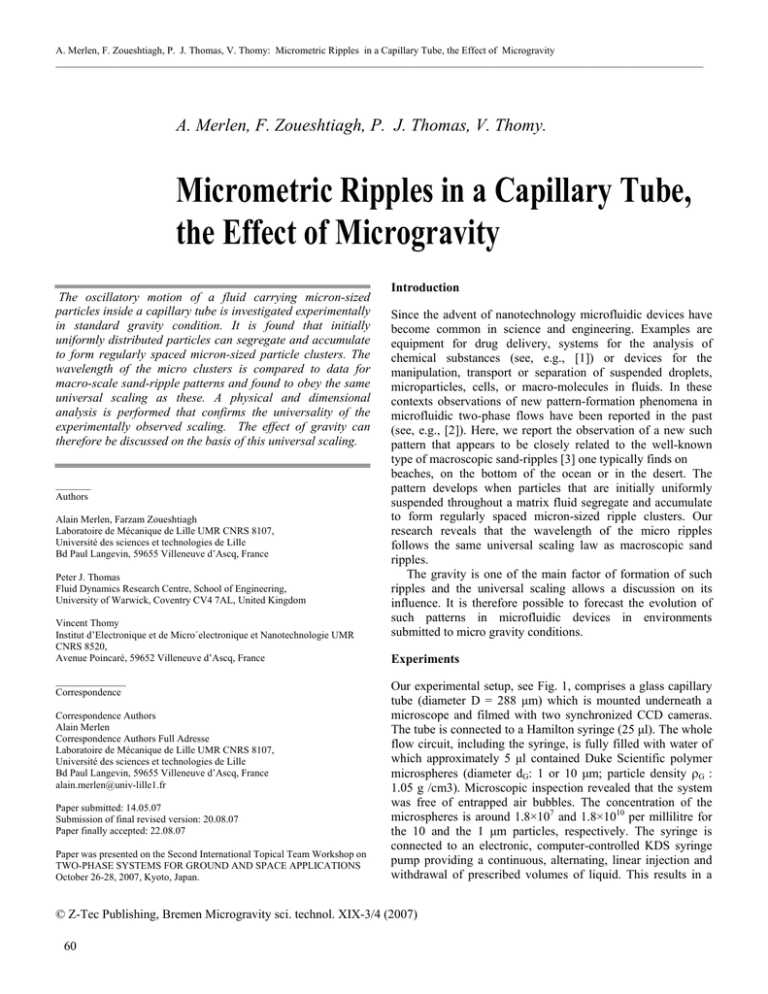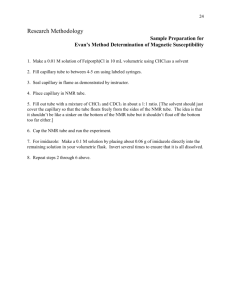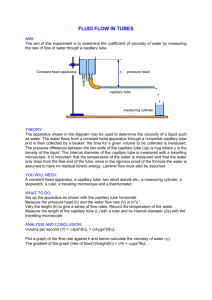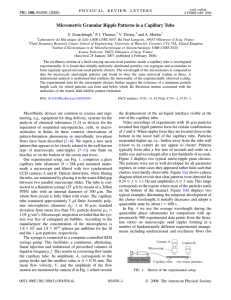Document 12847913
advertisement

A. Merlen, F. Zoueshtiagh, P. J. Thomas, V. Thomy: Micrometric Ripples in a Capillary Tube, the Effect of Microgravity _________________________________________________________________________________________________________________________________ A. Merlen, F. Zoueshtiagh, P. J. Thomas, V. Thomy. Micrometric Ripples in a Capillary Tube, the Effect of Microgravity The oscillatory motion of a fluid carrying micron-sized particles inside a capillary tube is investigated experimentally in standard gravity condition. It is found that initially uniformly distributed particles can segregate and accumulate to form regularly spaced micron-sized particle clusters. The wavelength of the micro clusters is compared to data for macro-scale sand-ripple patterns and found to obey the same universal scaling as these. A physical and dimensional analysis is performed that confirms the universality of the experimentally observed scaling. The effect of gravity can therefore be discussed on the basis of this universal scaling. _______ Authors Alain Merlen, Farzam Zoueshtiagh Laboratoire de Mécanique de Lille UMR CNRS 8107, Université des sciences et technologies de Lille Bd Paul Langevin, 59655 Villeneuve d’Ascq, France Peter J. Thomas Fluid Dynamics Research Centre, School of Engineering, University of Warwick, Coventry CV4 7AL, United Kingdom Vincent Thomy Institut d’Electronique et de Micro´electronique et Nanotechnologie UMR CNRS 8520, Avenue Poincaré, 59652 Villeneuve d’Ascq, France ______________ Correspondence Correspondence Authors Alain Merlen Correspondence Authors Full Adresse Laboratoire de Mécanique de Lille UMR CNRS 8107, Université des sciences et technologies de Lille Bd Paul Langevin, 59655 Villeneuve d’Ascq, France alain.merlen@univ-lille1.fr Paper submitted: 14.05.07 Submission of final revised version: 20.08.07 Paper finally accepted: 22.08.07 Paper was presented on the Second International Topical Team Workshop on TWO-PHASE SYSTEMS FOR GROUND AND SPACE APPLICATIONS October 26-28, 2007, Kyoto, Japan. Introduction Since the advent of nanotechnology microfluidic devices have become common in science and engineering. Examples are equipment for drug delivery, systems for the analysis of chemical substances (see, e.g., [1]) or devices for the manipulation, transport or separation of suspended droplets, microparticles, cells, or macro-molecules in fluids. In these contexts observations of new pattern-formation phenomena in microfluidic two-phase flows have been reported in the past (see, e.g., [2]). Here, we report the observation of a new such pattern that appears to be closely related to the well-known type of macroscopic sand-ripples [3] one typically finds on beaches, on the bottom of the ocean or in the desert. The pattern develops when particles that are initially uniformly suspended throughout a matrix fluid segregate and accumulate to form regularly spaced micron-sized ripple clusters. Our research reveals that the wavelength of the micro ripples follows the same universal scaling law as macroscopic sand ripples. The gravity is one of the main factor of formation of such ripples and the universal scaling allows a discussion on its influence. It is therefore possible to forecast the evolution of such patterns in microfluidic devices in environments submitted to micro gravity conditions. Experiments Our experimental setup, see Fig. 1, comprises a glass capillary tube (diameter D = 288 μm) which is mounted underneath a microscope and filmed with two synchronized CCD cameras. The tube is connected to a Hamilton syringe (25 μl). The whole flow circuit, including the syringe, is fully filled with water of which approximately 5 μl contained Duke Scientific polymer microspheres (diameter dG: 1 or 10 μm; particle density ρG : 1.05 g /cm3). Microscopic inspection revealed that the system was free of entrapped air bubbles. The concentration of the microspheres is around 1.8×107 and 1.8×1010 per millilitre for the 10 and the 1 μm particles, respectively. The syringe is connected to an electronic, computer-controlled KDS syringe pump providing a continuous, alternating, linear injection and withdrawal of prescribed volumes of liquid. This results in a © Z-Tec Publishing, Bremen Microgravity sci. technol. XIX-3/4 (2007) 60 A. Merlen, F. Zoueshtiagh, P. J. Thomas, V. Thomy: Micrometric Ripples in a Capillary Tube, the Effect of Microgravity __________________________________________________________________________________________________________________________________ reversing flow inside the capillary tube with rates between 0.001 μl/h and 60.68 μl/min. The mean flow velocity, V , and the amplitude (pump stroke), A, of the flow motion inside the capillary tube are monitored by camera B in Fig. 1 which records the displacement of the air-liquid interface visible at the end of the capillary tube. ρ GU 2 θ= g ( ρ G − ρ F )d G where U is a typical velocity scale characterizing the flow velocity that quantifies the forcing of the system. The solid line, λ/dG = 17.64 θ0.52 , in Fig. 3 is a least-squares fit from [4] interpolating the data points of the macroscopic sand ripples. Fig. 1: Sketch of the experimental set-up Experiments with dG= 10 μm particles revealed that patterns form for certain combinations of V and A. They typically develop after, approximately, a few tens of seconds and settle on a stable size and wavelength after a few hundreds of seconds. Figures 2(a) and (b) display two typical patterns with particles having arranged themselves into regularly spaced micro-ripple clusters. Fig. 3: dimensionless ripple wavelength, λ/dG, as a function of the mobility parameter. . It is possible to show by dimensional analysis that for dG very small compared with the global flow scales the wave length is related to the physical parameters by where φ is a friction coefficient f the frequency of the forcing and Δρ the difference between the grain and the fluid densities. Fig. 3 suggests that the parameters inside the parenthesis explain the dispersion cloud but that, roughly, λ varies like g −1 / 2 if nothing else than gravity changes. So if gravity is Fig. 2: Example of observed patterns (a) X100 magnification (b) X50 magnification. Results and discussion Fig. 3 presents the average wavelength measured during the quasi-stable phase (diamonds) for comparison with approximately 900 experimental data points from the literature (dots) on macroscopic sand ripples forming in a number of fundamentally different experimental arrangements (for details see [4]). The pattern wavelength is non-dimensionalized as (λ/dG) and a mobility parameter is defined as divided by 100, the wave length is multiplied by 10, moving the experimental data of our experiments (diamonds) toward the middle for fig 3. This means that micro gravity conditions probably increase the separation capacity of an oscillating micro flow on micro particles not sensitive to Brownian motion. References [1] H. A. Stone and S. Kim, AIChE Journal 47, 1250 (2001). [2] F.-K. Tsai, J. L. Lauer, and J. L. Shohet, J. Appl. Phys. 99, 024701 (2006). [3] R. A. Bagnold, The Physics of Blown Sand and Desert Dunes (Methuen, London, 1941) [4] F. Zoueshtiagh and P. J. Thomas, Phys. Rev. E 67, 031301 (2003). Microgravity sci. technol. XIX-3/4 (2007) 61






